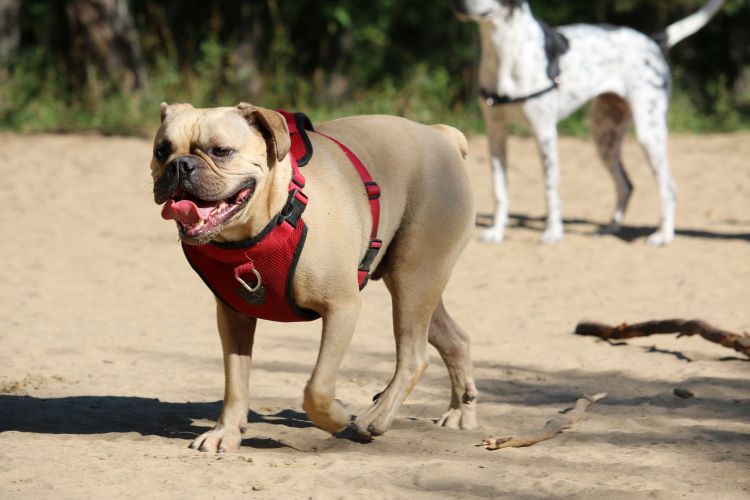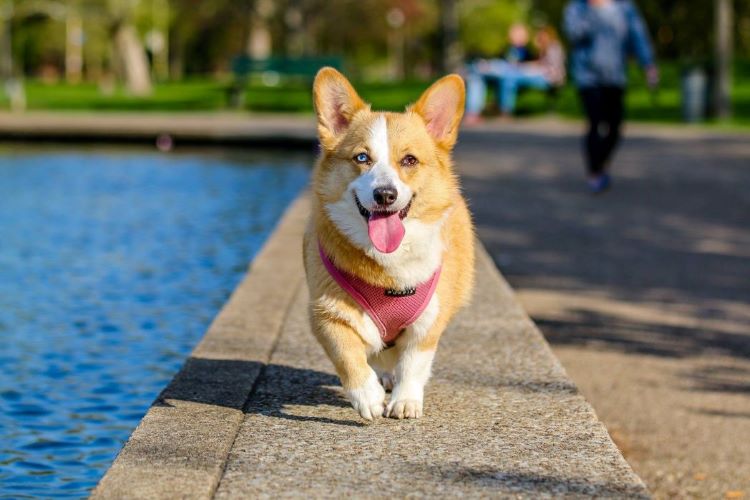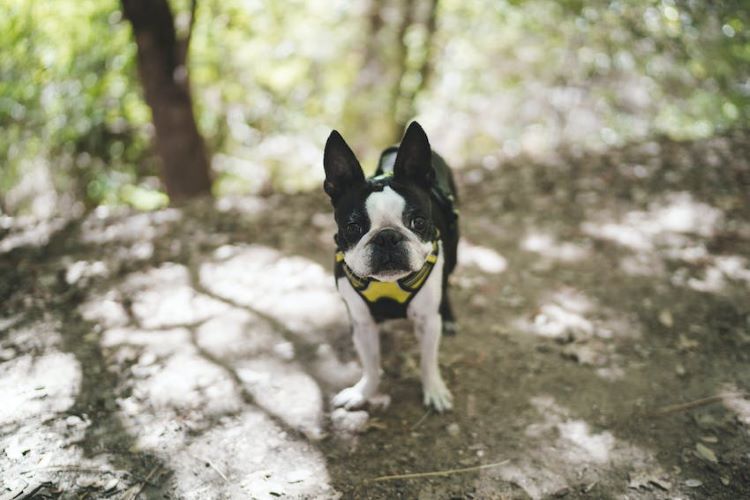Ready to help treat your pet to a healthy life?
Tips to Choose the Right Dog Harness
By : Brianna Gunter | Published Nov 16, 2023

If you're a dog owner, you know that choosing the right supplies for your canine companion is crucial. One of the most important accessories you'll need is a dog harness. Increasingly common in recent years, harnesses help provide better control when taking your dog on adventures and can be better for their spine and neck than a traditional dog collar. However, it’s important to make sure you have a harness that is well-suited for your pup’s size and breed.
Wondering what to look for? Let’s explore why canine harnesses are used in the first place and how you can find the right fit for your pet.
Dog harnesses vs. collars
Both dog collars and harnesses are common pet accessories used to attach leashes and guide your pal while out and about. A collar goes around your dog’s neck while a harness straps around your dog’s upper torso. According to Kathy Pitts, lead dog walker of Trupanion’s Pet Operations team, harnesses are greatly preferred over collars.
“Harnesses give you a much greater degree of control and almost zero chance of the dog slipping out,” she explains. While the choice is up to the individual dog owner, harnesses offer several key advantages over traditional collars:
- Reduce strain and risk of neck and throat injury
- Discourage pulling
- Give you (or a dog walker) better control
- Are tougher for dogs to escape from
- Can make it easier to lift your dog when needed
- Can be more supportive and comfortable for dogs, especially those with mobility issues or certain health conditions
- Can help prevent leash tangling
Ultimately, the choice of using a dog harness is up to the individual pet owner. If you have an older dog who stays calm and non-reactive on walks, they may be just fine with an old school collar and leash setup. More active dogs, puppies, and dogs who are still learning behavioral skills may do better with a harness.
The importance of a properly fitted harness
When used correctly, dog harnesses can provide better handling and a more pleasant walking experience for human and canine alike. But when not fitted correctly, dog harnesses can increase the risk of injury and may make it easier for dogs to wriggle out of them. You don’t want a harness that is too loose or flimsy, just as you don’t want one that is too tight and cutting off your dog’s circulation.
Remember, your dog’s wellbeing comes first. If the harness appears to be causing them discomfort or is resulting in skin irritation, it’s time to find another option.

Types of canine harnesses
There are several types of dog harnesses, each designed for specific purposes. The most common types include:
- Back-Clip Harness: These harnesses have a D-ring on the dog's back, making them ideal for smaller dogs and those who don't pull excessively.
- Front-Clip Harness: Front-clip harnesses have a D-ring on the chest, which discourages pulling. They are excellent for training and controlling strong, energetic dogs.
- Step-In Harness: These are easy to put on and are great for dogs that dislike having harnesses slipped over their heads.
- No-Pull Harness: Designed to discourage pulling behavior, these often have both front and back D-rings for added control.
- Safety Harnesses: These are designed to keep your dog safe during car rides. They attach to a seatbelt to secure your pet while driving.
Choose the type that suits your dog's size, personality, and specific needs. You’ll also want to look at where the leash clips in. According to Pitts, “clipping the leash to the front of the harness can be a great deterrent.”
Tips for choosing a dog harness
There are a few essential factors to consider when shopping around for the right harness for your dog. Keep in mind that you may need to try out a few harnesses and go through a period of trial and error before finding the best one for your pet and your needs as a dog owner.
Visit a pet supply store
You may be able to find a lot more options online, but it’s a good idea to visit a pet store and look at harnesses in person to get a better idea of what you’re looking for. Size charts and adjustable features can mean a lot more when you’ve actually seen different kinds of harnesses in person. If you can, bring your dog along and hold up harnesses to see what might best align with their size and shape. You may also want to try clipping your leash on different designs to see what you’re comfortable with (if buying a new leash at the same time as a harness, this is also a great opportunity to compare different options in person).
Look at size and fit
The first and foremost consideration when actually choosing a dog harness is ensuring it fits your pal perfectly. A harness that is too tight can be uncomfortable, while one that is too loose may allow your dog to slip out. To find the right size, measure your dog's girth, which is the circumference of their chest just behind their front legs. Consult the manufacturer's sizing chart (usually available online if not on the packaging itself) to match your dog's measurements to the appropriate harness size.
”The harness should be snug but not tight,” Pitts advises. “You should be able to slide 2 fingers under each strap. Check under your dog’s leg and behind their elbow for any signs of chafing and rubbing and readjust as needed.”
Choose a harness size that matches your dog's measurements. If your dog falls between sizes, it's usually best to go with the larger size.
Opt for simplicity and ease
Since dog harnesses have become so popular in recent years, there are now more designs than ever to choose from. It may seem like a simple matter of choosing the one you think looks best. But according to Pitts, style is actually a very important factor when it comes to function and safety.
“In my experience, the more basic the harness, the safer it is,” Pitts says. “Where there are more straps and padding, fitting becomes more complex and there is more opportunity for the dog to slip out.”
It’s also important that your dog harness is easy for you to take on and off your pet. Look for straightforward features like quick-release buckles and non-complex straps so you can look forward to hassle-free walks.
Look for durability and washability
Invest in a harness that can withstand wear and tear. Dogs can get messy, so you’ll also want to choose a harness that is easy to clean. Many harnesses are machine washable, and some have removable, washable padding.
No matter what kind of canine harness you get, keeping it clean is important for your pup’s health. A harness with dirt and other outdoor buildup can cause irritation and may even be harboring bacteria.
Pitts and her team recommend the Wonder Walker harness for simplicity and durability.
Allow for future adjustability
This is especially important for growing puppies! A good harness should be adjustable to accommodate your dog's growth and ensure a snug fit. Look for harnesses with adjustable straps around the neck and chest, as well as ones with multiple points of adjustment for a custom fit.
Again, you may need to try a few different options before finding a harness that works for you and your pet, but make sure you’re only trying ones that are rated for your dog’s size and weight. Asking your veterinarian for recommendations is a good idea.

How to properly fit a dog harness
Once you’ve selected a dog harness, it’s time to make sure it fits correctly on your pet. Follow these four easy steps:
1. Adjust before putting on
Lay the harness flat on the ground and ensure all the straps are untangled.
Identify the front and back straps. The front strap typically goes around your dog's chest, while the back strap goes around their torso, just behind the front legs. Adjust the straps to their loosest setting before putting the harness on your dog.
2. Put the harness On
Encourage your dog to step into the harness with their front legs through the leg holes. Lift the harness up over your dog's back, positioning it so that the front strap is across their chest and the back strap is parallel to their spine.
If the harness is not a step-in design, you’ll have to line up the D-ring first (on your dog’s front or back, depending on the style) and then wrap the straps around them while holding the ring in place.
3. Fasten the buckles
Secure the buckles on the side of the harness. Make sure they are fastened snugly but not too tight. You should be able to comfortably fit two fingers between the harness and your dog's skin.
4. Adjust the fit
Ensure that the front strap is not cutting into your dog's armpits or restricting their movement. Check the back strap to ensure it sits flat against your dog's back, without twisting or shifting.
Make sure the harness is snug but not overly tight. It should be snug enough to prevent your dog from slipping out but loose enough to allow for comfortable movement and breathing.

Make safety a priority
Using a dog harness doesn’t mean you should be more lax about safety when out and about with your dog. Always be aware of your surroundings and practice good dog walking etiquette. And for cloudy days and night walks, you’ll want to make sure you and your pet are wearing items with reflector strips (the good news is that many modern harnesses already come with these).
That said, accidents can happen at any time, even when precautions are taken. Before you set out on your next dog walk or outdoor adventure, take a few minutes to explore your dog insurance coverage options to protect your pet.
*Trupanion does not receive compensation for any products that are mentioned in this article. Linked products are for informative purposes only.
